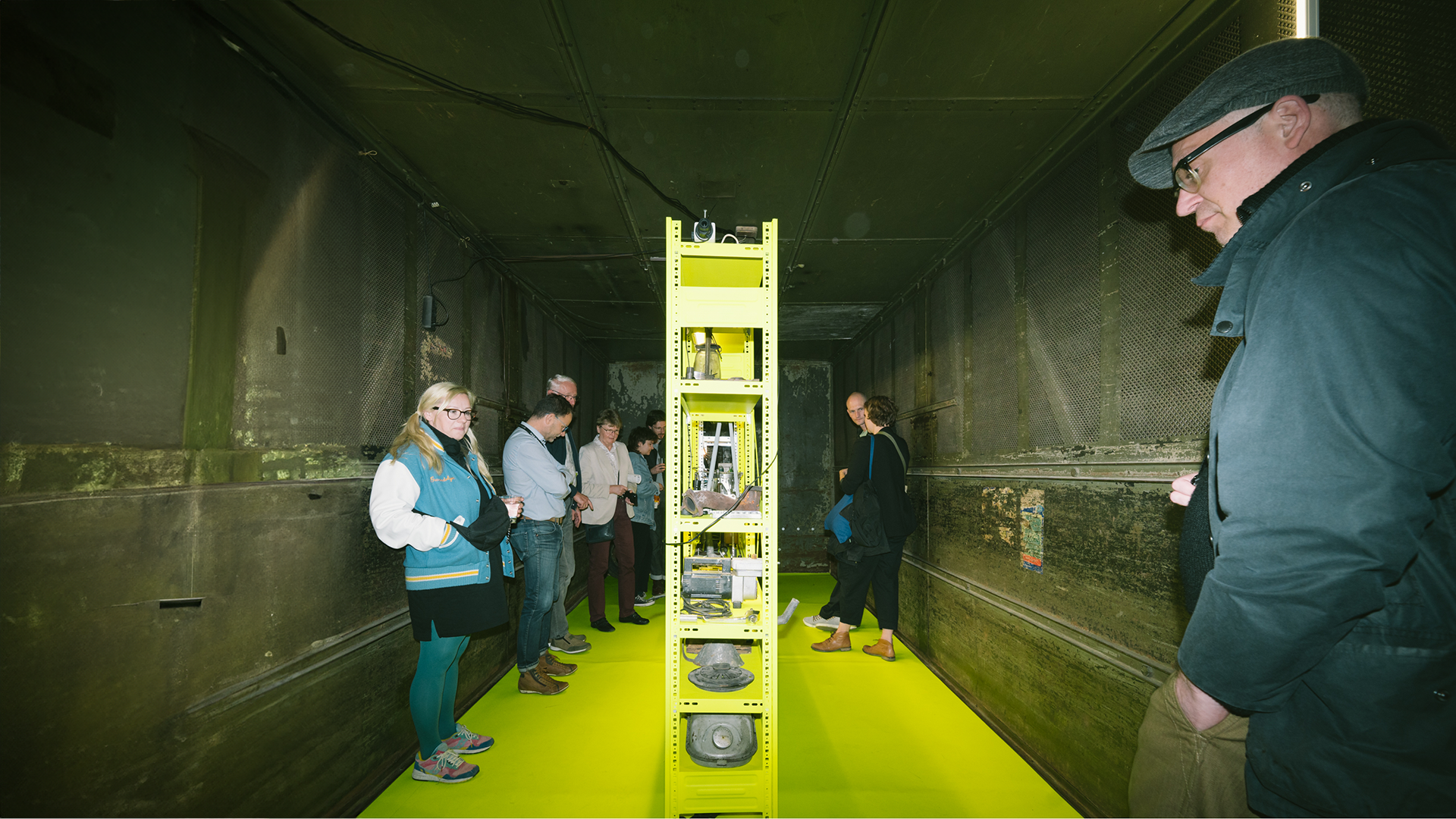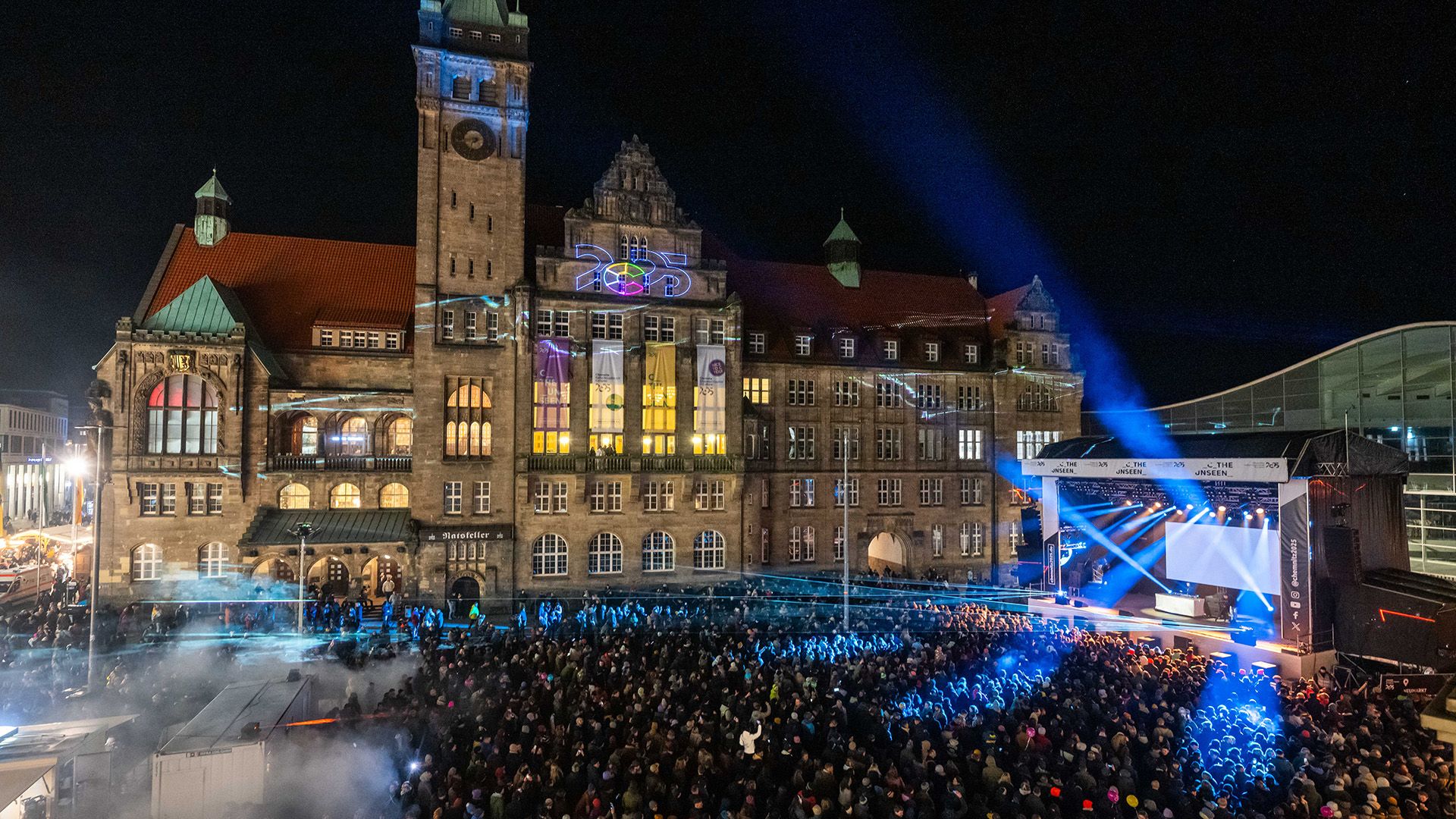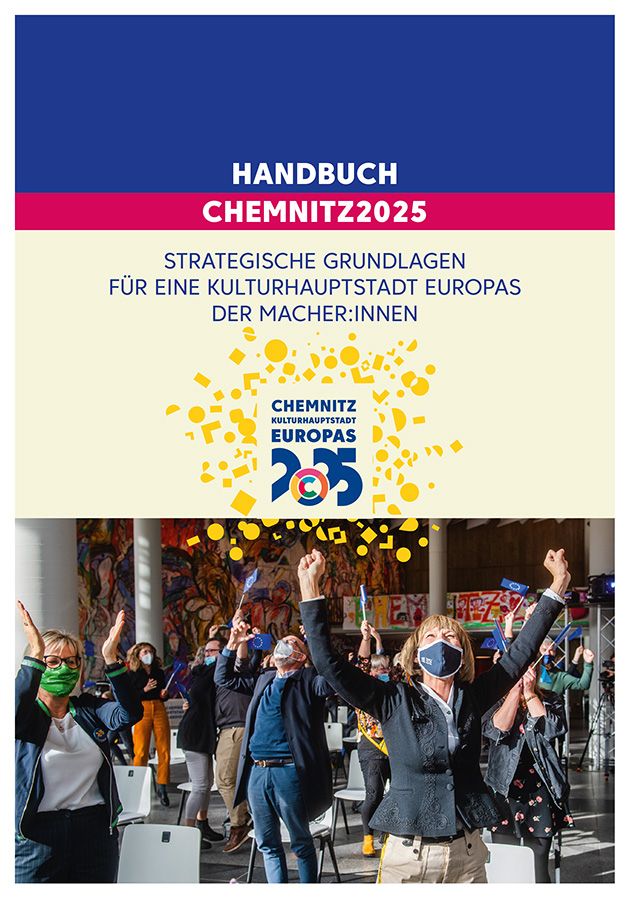
Chemnitz 2025
See the unseen
"C the Unseen" is the motto of the European Capital of Culture in Chemnitz with 160 projects such as the #3000Garages. In GDR times, garages were places of retreat and encounter, but what knowledge is hidden here in times of scarce resources and the beginning of a circular economy? The picture shows the vernissage "Ersatzteillager" by Martin Maleschka. Photo: Chemnitz 2025, Johannes Richter
"C the Unseen" is the motto of the European Capital of Culture in Chemnitz with 160 projects such as the #3000Garages. In GDR times, garages were places of retreat and encounter, but what knowledge is hidden here in times of scarce resources and the beginning of a circular economy? The picture shows the vernissage "Ersatzteillager" by Martin Maleschka. Photo: Johannes Richter
Anti-European voices are causing divisions within the European Union, making the idea behind the European Capital of Culture more relevant than ever: uniting Europe through culture. But how can cultural participation foster social cohesion? Chemnitz 2025 seeks answers, using events to create visible spaces for dialogue and connection.
Europe should be united through culture, providing a space for encounters where people can find their place within the community, both in time and space. With this vision, Greek Minister of Culture Melina Mercouri launched the European Capital of Culture initiative in 1985.
Forty years later, as the EU shifts to the right and democracy comes under pressure, the European Capital of Culture year is more relevant and attention-grabbing than ever.
With the title European Capital of Culture, the European Union wants to celebrate the diversity of cultures in Europe, consolidate the commonalities of Europeans, strengthen their sense of belonging and support the development of cities. This year, Chemnitz and its sister cities, Nova Gorica in Slovenia and Gorizia in Italy, will be celebrating this. What the three cities have in common is that they are rather unknown. The Capital of Culture year aims to change that.
"C the Unseen“
The Chemnitz 2025 application was driven by civil society. Under the motto "C the Unseen," the city’s 250,000 residents aim to shed light on the overlooked and invite visitors on a journey of discovery to eastern Germany.
(November 18, 2024), he writes: "The flexibility and adaptability of the people in East Germany are remarkable in every respect.For Marcel Fratzscher, President of the German Institute for Economic Research (DIW Berlin), the past 35 years of transformation in East Germany represent one of the greatest success stories in German history. In his blog post "Why We Should Draw Confidence from East Germany" (November 18, 2024), he writes: "The flexibility and adaptability of the people in East Germany are remarkable in every respect." For the President of the German Institute for Economic Research (DIW Berlin), Marcel Fratzscher, the last 35 years and the transformation in East Germany are one of the greatest successes in German history. Not to be forgotten: In 1953, the GDR leadership renamed Chemnitz to Karl-Marx-Stadt. Following the peaceful revolution in 1990, residents voted to restore the city's original name.
The Saxon city is the fourth German Capital of Culture, following West Berlin (1988), Weimar (1999), and Essen (2010). At the opening ceremony on January 18, 2025, Federal President Frank-Walter Steinmeier emphasized that Chemnitz 2025 should send a strong signal of unity. He added that the Capital of Culture year could foster cohesion by actively involving citizens.
Federal President Frank Walter Steinmeier at the opening of the European Capital of Culture year in Chemnitz: Chemnitz 2025 should send out an unmistakable signal for cohesion.
Photo: Chemnitz 2025, Kristin Schmidt
Marko Roscher shares the Federal President’s view: " The Capital of Culture year can contribute to greater cohesion", says the " CHemnitzer with heart and soul", adding, "The important thing is to get involved and participate".
During the opening weekend at Chemnitz City Hall, the sustainability officer at fwd: Bundesvereinigung Veranstaltungswirtschaft (Federal Association of the Event Industry) was struck by how many people are actively engaged in the Capital of Culture program and its regional projects.
Let's celebrate: Opening | European Capital of Culture Chemnitz 2025
European movers and shakers of democracy
However, the opening was marked by protests from right-wing extremists and counter-protests from democratic groups. The fact that Saxony’s third-largest city struggles with right-wing extremism is something its residents openly acknowledged in their application.
On the contrary: the Chemnitz 2025 Bidbook begins with two international articles highlighting the violent protests of 2018—"Chemnitz Protests Show New Strength of Germany's Far Right" (The New York Times) and "Thousands Turn Out for Chemnitz Anti-Racism Rock Concert" (The Guardian). The people of Chemnitz are being honest. Their narrative, "C the Unseen – European Makers of Democracy," seeks to answer a fundamental question: How can cultural and civic participation strengthen social cohesion?
This question forms the foundation of the European Makers of Democracy project. Through numerous interactive events, participants are encouraged to see themselves as creators of change, actively shaping their social environment—whether at the European Workshop for Culture and Democracy or in the workshops led by Team Generation and CREATE U.
Create visible spaces
"We are living in a time when democracies around the world are under pressure—in the USA, in many parts of Europe, and also here in Saxony and Chemnitz," says Dr. Ralf Schulze, Managing Director of C3 – Chemnitz Event Centres, in an interview.
In this context, he sees culture as a bridge—one that fosters encounters, strengthens social cohesion, and opens up new perspectives.

Photo: Dirk Hanus
"Culture is the heartbeat of our democracy"
Dr Ralf Schulze, Managing Director of C3 - Chemnitz Event Centres, on the European Capital of Culture Chemnitz 2025, visible spaces for democracy and unconventional venues for events, the maker city of Chemnitz and the revitalisation of the congress business, the Purple Path and other impulses for planners.
"Cross-border projects with our European neighbors—particularly with Poland and the Czech Republic—remind us that far more unites us than divides us," emphasizes Schulze. He stresses that values like openness, tolerance, and mutual respect are not a given; they must be actively lived and defended time and again.
But for him, dialogue alone is not enough. "Democracy needs visible spaces where the broad democratic center can assert and strengthen itself. Because where commitment, cohesion, and co-creation take center stage, there is no room for the enemies of democracy."
Participate, create, makers united
More than 1,000 events in Chemnitz and 38 municipalities across Central Saxony, along with 160 Capital of Culture projects, offer ample opportunities for participation. The largest of these is the Purple Path, an art and sculpture trail that narrates the 850-year history of mining, which has shaped the Ore Mountains, Central Saxony, and the Zwickau region. Sculptures and installations link Chemnitz with its partner municipalities in the surrounding areas.
Industry and culture go hand in hand in Chemnitz. The Industrial Museum showcases three centuries of industrial development - from the single-cylinder back-pressure steam engine from 1896 to modern industrial robots. The nine Makerhubs, for example in the Esche Lab, the workshop for creative textile work, aim to create something new together. The Makerhub NETZ-Werk in Neukirchen, located in the Ore Mountains, revolves around cooking. A former car dealership has been transformed into a culinary meeting hub, featuring an open kitchen spanning 220 square meters. Three modern cooking stations accommodate 30 to 40 people, while the adjacent seating area provides space for 80 individuals to collaborate and socialize, complemented by an additional 400 square meters of event space. The opening of the community and event kitchen attracts 1,000 visitors. In June, technology, craftsmanship, art, and science will converge at the Makers United hands-on trade fair at Chemnitz City Hall. Hall manager Schulze views this as a significant opportunity for Chemnitz to strengthen its position as a congress and trade fair city. The international festival for creativity, technology, and innovation provides a platform for companies, scientists, and creative professionals to present new ideas and network. Schulze adds, "This fosters new connections between tradition and innovation, positioning Chemnitz as a dynamic business and event destination. The long-term goal of establishing Chemnitz as a city of makers is also a key part of this initiative. The corresponding KPIs (key performance indicators) are outlined in the bid book: Between 2023 and 2026, 80 million people are expected to visit the maker space, and 2.4 million people are projected to participate in the cultural program. Creative and maker tourism is set to be introduced in the region, with an expected annual growth of 25 percent between 2024 and 2026. Lastly, for every 91 million euros invested in the Capital of Culture year, at least three euros should be generated in return, primarily through tourism.

Rave at Neumarkt in Chemnitz. The European Capital of Culture has 1,000 events in its programme. Photo: Chemnitz 2025, Kristin Schmidt
Two million visitors
The German National Tourist Board (GNTB) is collaborating with Chemnitz Tourism and Marketing (CTM) to promote Germany in key source markets, including Austria, Switzerland, the Czech Republic, Poland, the Netherlands, and Denmark. Of the 173 million cultural trips made by Europeans in 2023, 18.7 million were to Germany, and the number of city trips to Germany increased by another ten percent in the first eight months of 2024, according to IPK International. "In this context, the 'Chemnitz European Capital of Culture 2025' event provides additional incentives to explore this region within Germany's artistic and cultural landscape," says Petra Hedorfer, Chairwoman of the GNTB Executive Board.

Handbook Chemnitz 2025 - Strategic foundations for a European Capital of Culture of the makers:inside
The city aims to attract two million visitors, including day tourists. In 2023, Chemnitz's accommodation providers counted 251,395 arrivals. According to Chemnitz Tourism and Marketing, which is to be dissolved at the end of the year, the booking situation is good and there are enough rooms with a total of 4,000 guest beds. Weekends when there are hardly any hotel rooms available should be the exception and hotels and guesthouses in the region should offer alternatives. "If you're not lucky enough to get a hotel room in Chemnitz now, you're in good hands in the Ore Mountains or in Zwickau and have a short journey to Chemnitz," says Jan Burghardt, Director of the Congress Hotel Chemnitz, in the news programme ZDF heute. His hotel has 226 rooms, ten conference and event rooms for meetings and events with up to 350 participants. With direct access to the Stadthalle Chemnitz, it can be expanded to accommodate up to 2,000 participants.
The Chemnitz Convention Bureau supports event planners in exploring the European Capital of Culture and its region under the motto "C the Unseen" and helps with the search for locations, networking with local expert networks and the creation of a supporting programme of tangible industrial, sub- and high culture. For the people of Chemnitz, the title of European Capital of Culture is "a driving force for the city's conference and congress scene". After all, events related to the European Capital of Culture have been and will continue to be held in Chemnitz, such as last year's World Robotic Olympiad 2024 at Chemnitz University of Technology or this year's annual conference of the German Society for Veterinary Dermatology at the Carlowitz Congress Centre Chemnitz or the Federal Congress of the Fonds Soziokultur in cooperation with the City of Chemnitz's culture department at the Garagen-Campus Chemnitz. These events will promote bleisure travel. After all, people travelling for a congress or conference will take a look at the Chemnitz 2025 programme and stay longer or come back, according to Chemnitz Tourism and Marketing. "There are plenty of options for combining business and leisure," says fwd: sustainability officer Marko Roscher. In addition, the motto "C the Unseen" is an invitation for event professionals in search of the unknown and new. He is thinking of places such as Wirkbau and Weltcho, Kraftverkehr and Kraftwerk or the Oberdeck Chemnitz. Roscher: "Of course, it's cool to combine your business event with one of the highlights." He is thinking of the Hutfestival from 30 May to 1 June 2025, Kosmos Festival from 13 to 15 June 2025, the makers united festival on 20 and 21 June and the Cosmos Festival on 20 and 21 June. and 21 June and the European Peace Ride from 10 to 13 September 2025 from Passau via Plzeň and Ústí nad Labem in the Czech Republic to Chemnitz. In April, Marko Roscher will attend the opening of the #3000Garagen project.
New for our international readers:
For the first time, we are offering an English version of our magazine in addition to the German edition. The translation was made with the help of AI and is currently in the test phase. We’d love to hear your feedback on this new service!